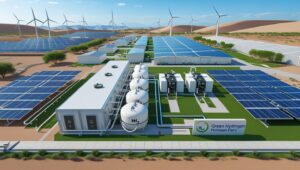 In a significant step toward deepening bilateral cooperation and tackling global environmental challenges, the European Union and India have jointly announced two landmark initiatives under the EU-India Trade and Technology Council (TTC). With a combined investment of €41 million, the projects aim to address marine pollution and accelerate development in hydrogen-based clean energy technologies, showcasing a shared commitment to sustainable innovation and geopolitical partnership.
In a significant step toward deepening bilateral cooperation and tackling global environmental challenges, the European Union and India have jointly announced two landmark initiatives under the EU-India Trade and Technology Council (TTC). With a combined investment of €41 million, the projects aim to address marine pollution and accelerate development in hydrogen-based clean energy technologies, showcasing a shared commitment to sustainable innovation and geopolitical partnership.
Research & Innovation: A New Chapter in EU–India Collaboration
Backed by the EU’s Horizon Europe programme and Indian ministries, the two projects mark a major milestone in international scientific cooperation. By uniting researchers, startups, and industries from both regions, the initiatives aim to develop breakthrough solutions that are globally impactful and locally relevant.
Tackling Marine Pollution: A Priority for Planetary Health
The first of the two research efforts focuses on curbing marine pollution, particularly the growing threat of plastic waste and microplastics in oceans. Co-funded by the European Union and India’s Ministry of Earth Sciences, the project supports cutting-edge innovations aligned with the UN Decade of Ocean Science and global marine health objectives.
Clean Hydrogen from Waste: A Leap Toward Energy Transition
The second initiative targets the development of clean hydrogen technologies derived from waste. In partnership with India’s Ministry of New and Renewable Energy, this project seeks to establish sustainable hydrogen production systems that will be central to achieving long-term energy security and a decarbonized future.
Strengthening the TTC Framework
These joint research calls are open to institutions and companies across both regions, promoting wide participation and innovation. Further collaborative calls are expected in 2026, reinforcing the enduring momentum of the TTC agenda launched by European Commission President Ursula von der Leyen and Indian Prime Minister Narendra Modi in 2022.
By aligning technological advancement with environmental responsibility, these initiatives mark a powerful step forward in global climate leadership driven by the strong and growing EU–India partnership.
The EU–India initiatives focused on marine pollution and waste-to-hydrogen technology have the potential to significantly support global climate goals in the following ways:
1. Reduction of Ocean Plastic Pollution:
By targeting marine plastic waste and microplastics, the first initiative directly contributes to UN Sustainable Development Goal 14 (Life Below Water). Healthier oceans mean improved carbon absorption, as marine ecosystems especially phytoplankton play a vital role in regulating global carbon dioxide levels. Cleaner oceans also bolster climate resilience for coastal communities.
2. Advancement of Clean Hydrogen:
The second initiative centered on producing renewable hydrogen from waste is aligned with global decarbonization goals and the Paris Agreement. Hydrogen is a clean fuel with the potential to replace fossil fuels in industries like steel, cement, and heavy transport. By focusing on sustainable hydrogen derived from waste, the project also addresses the dual challenge of waste management and clean energy.
3. Strengthening Global Research Networks:
These projects are not just bilateral they are designed to invite broad collaboration across sectors in Europe and India. This fosters innovation ecosystems that can produce scalable, globally transferable technologies, thereby accelerating collective climate action.
4. Long-Term Policy Alignment:
The initiatives reinforce policy cooperation between two major global players. The institutional framework of the EU–India Trade and Technology Council ensures continued alignment of climate strategies, supporting frameworks like the EU Green Deal and India’s Panchamrit commitments (announced at COP26).
5. Catalyzing Investment and Innovation:
The €41 million funding provides a strong signal for public and private stakeholders to invest in climate tech and green innovation. This can trigger additional funding, commercialization, and real-world application scaling impact beyond just the initial research.
In summary, these initiatives serve as a bridge between technology, diplomacy, and sustainability enabling meaningful contributions to climate mitigation, resilience, and the global transition to a green economy.
Written by Vaishali Verma
Sub-editor, DisastersNews
